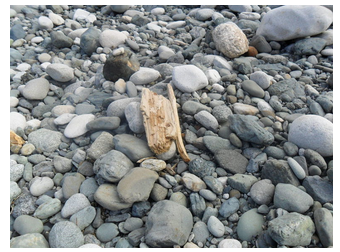7.2: Siliciclastic Sediments
- Page ID
- 17543
| classification | particle/clast size (diameter in mm) |
|---|---|
| boulder | >256 |
| cobble | 64 to 256 |
| pebble | 4 to 64 |
| gravel or granule | 2 to 4 |
| sand | 1/16 to 2 |
| silt | 1/256 to 1/16 |
| clay | <1/256 |
The term siliciclastic refers to sediments composed mostly of silicate minerals. The most common sedimentary rocks – including shale, sandstone, and conglomerate – form from siliciclastic sediments. Other kinds of sedimentary rocks consist of carbonates (in limestones), iron oxides and hydroxides (such as hematite or goethite in iron formation), or other minerals.
Geologists classify siliciclastic sediments based on grain size. The standard classification system is the Wentworth Scale (see table). Depending on size, clasts may be boulders, cobbles, pebbles, gravel, sand, silt, or clay. The word clay sometimes causes confusion. Sedimentary petrologists use the term to refer to clastic grains smaller than 0.004 mm in longest dimension. They also use the term, however, to refer to minerals of the clay mineral group, no matter the grain size.
Clast sizes vary from fine clay and silt to huge boulders. Small clasts are usually composed of a single mineral, generally quartz or clay. Larger clasts are commonly lithic fragments composed of multiple minerals. The photos below show some examples of sediment containing different kinds and sizes of clasts.




Figure 7.8 is a view of mud along a river in Tasmania. The mud comprises fine grains of silt and clay. Figure 7.9 shows sand from Pfeiffer Beach, California. Quartz dominates most common sand, but the sand seen here contains mostly rosy garnet, and also epidote, zircon, magnetite, spinel, staurolite, and only minor quartz. Figure 7.10 shows centimeter scale pebbles on a beach in Greece. Most of the pebbles are lithic fragments (rock fragments) composed of more than one mineral. Figure 7.11 shows cobbles in a dry river bottom. These cobbles are all lithic fragments. The mineral grains in the Pfeiffer Beach sand are angular, but the clasts in the last two photos have been well rounded by abrasion due to tumbled during transportation by flowing water.


